Jülich circular path 1 and 2
| Jülich circular path 1 and 2 | |
|---|---|
|
historical recording
|
|
| Numbering: |
Jülich circular orbit 1 and 2 DEG 1 and 2 |
| Number: | 2 |
| Manufacturer: |
Humboldt , Cologne serial numbers 735 and 736 |
| Year of construction (s): | 1910 |
| Retirement: | until 1966 |
| Type : | B n2t |
| Gauge : | 1435 mm ( standard gauge ) |
| Length over buffers: | 7,505 mm |
| Length: | 6,190 mm |
| Height: | 3,787 mm |
| Total wheelbase: | 2,300 mm |
| Empty mass: | 18.85 t |
| Service mass: | 25.35 t |
| Friction mass: | 25.35 t |
| Wheel set mass : | 13 t |
| Top speed: | 40 km / h |
| Driving wheel diameter: | 1,030 mm |
| Number of cylinders: | 2 |
| Cylinder diameter: | 320 mm |
| Piston stroke: | 520 mm |
| Boiler overpressure: | 12 bar |
| Number of heating pipes: | 120 |
| Heating pipe length: | 2,950 mm |
| Grate area: | 0.8 m² |
| Evaporation heating surface: | 55.7 m² |
| Water supply: | 3.5 m³ |
| Fuel supply: | 1 t |
| Brake: |
Hardy brake handbrake |
The tank locomotives Jülich orbit 1 and 2 were steam locomotives with the wheel arrangement B.
They drove on the Jülich Kreisbahn from 1910 and were in use until the mid-1960s. Locomotive number 1 was erected as a memorial in Köttingen in 1972 . Since 1996 it has been at Spoorweg-Maatschappij Zuid-Beveland in the Netherlands .
history
The locomotives were part of the original equipment of the Jülich Kreisbahn and carried out both passenger and freight traffic on the line. Despite the gradients of up to 20 ‰, the small locomotives met the requirements for transport tasks for decades. It was not until 1952 that passenger traffic was carried out with a multiple unit , the freight trains during the beet campaign were served by an ELNA 2 from 1959 .
From 1960 they received the name of the German Railway Company . They kept their original numbering and were the company's only two-axle locomotives. The 2 was shut down in 1961 and scrapped in 1963. The 1 drove until 1966, when it was parked, erected as a memorial in 1972 and sold to the Netherlands in 1996 . It should be restored to roadworthy condition at the Spoorweg-Maatschappij Zuid-Beveland association.
technology
The locomotive had an inner frame and a wheel diameter of 1,030 mm. The water tank was stored between the frame cheeks. The box on the right side was possibly used as a water tank, as it had a larger water supply than the four-axis Marburg circular path 5 . The other side box was used as a coal box. The inlet ports for the water are directly in front of the side boxes. The locomotive is equipped with a small sandpit, one of which was manually sanded from the inside, a Ramsbotton type safety valve placed in front of the driver's cab and a bell between the sandpit and the safety valve.
The axles of the locomotive were suspended by leaf springs; on the front axle the spring was above the frame, on the rear axle below the axle bearings. Only the rear axle was braked on both sides.
The steam engine worked according to the wet steam process . The boiler had 120 tubes with an inside diameter of 41 mm, an outside diameter of 46 mm and a tube length of 2,950 mm.
literature
- Gerd Wolff: German small and private railways Volume 4: North Rhine-Westphalia southern part . EK-Verlag, Freiburg 1997, ISBN 3-88255-660-9 , p. 9-18 .
See also
Web links
- Data sheet about locomotive 1 at www.dampflokarchiv.de
- Data sheet about locomotive 2 at www.dampflokarchiv.de
Individual evidence
- ↑ a b c Gerd Wolff: German small and private railways Volume 4: North Rhine-Westphalia southern part . EK-Verlag, Freiburg 1997, ISBN 3-88255-660-9 , p. 9-18 .
- ↑ a b Sketch of the locomotive on a Humboldt sketch
